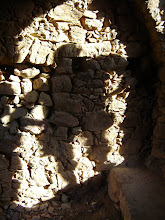If I forget to switch my mobile phone to silent, it may suddenly spring into life when my telecom provider decides to welcome me by text message to Germany. It’s slightly bizarre, since Rolduc Abbey - where I occasionally perform guided tours to English-speaking visitors - is actually in Kerkrade in the Netherlands. But only just.
The towns of Herzogenrath (in Germany) and Kerkrade (in the Netherlands) are separated by an international border. This hasn’t always been the case. As far back as the 12th century the towns formed a single geographic and administrative entity, known as the Land of Rode. Back then, it was ruled by the Counts of Saffenburg, who resided in Burg Rode, which survives to this day in the centre of modern-day Herzogenrath.
Through the ages, the map of the region was subject to constant change, like the ebb and flow of the tide. The wider region was a confused collection of duchies, fiefdoms and manors, which were likely to change hands without warning. The local rulers might lose their lands at the throw of a dice, or have them given away as a dowry: that’s if they hadn’t already been invaded by enemy troops. Despite the tumultuous times, Kerkrade and Herzogenrath nevertheless managed to remain united under the name of Landes Herzogenrath.
Rode, -rath, -rade are suffixes which can be found in many place names throughout the southern Netherlands and the Rhineland. They originate from the Dutch word rooien (German = roden), which means to clear land from forest (for example, for cultivation and settlement). Herzogenrath, Kerkrade and Klosterrath would have started out life as clearings in the forest.
In 1804, the jumbled patchwork of lands which included the Land of Rode, were abolished and the whole region was incorporated into Napoleon’s Greater French Empire. Rode-le-duc, or Rolduc, became the French name for Herzogenrath - nowadays this name refers exclusively to the abbey of the same name which had been founded in 1104, and known locally as Klosterrath, now in present-day Kerkrade.
When Napoleon was defeated at Waterloo, the borders were once again redrawn and the Land of Rode was split asunder. At the Congress of Vienna in 1815, new borders were seemingly arbitrarily drawn. The border between the Netherlands and Prussia sliced the Land of Rode in two, with Rolduc (i.e. the abbey) and Kerkrade falling into Dutch hands, and Burg Rode (in Herzogenrath) being assigned to Prussia. Kerkrade became part of the Netherlands, and Herzogenrath Prussia, thus wiping the Land van Rode from the map in one fell swoop after seven centuries of unity.
Even after the division of lands following the Napoleonic wars, the border between the two towns never presented much of an obstacle to normal contact between citizens on either side. Life went on much as before: citizens on both sides spoke the same dialect, pursued the same cultural and social activities, and inter-married across the newly created divide.
This situation only changed with the outbreak of the First World War in 1914. For the first time ever, a physical barrier was thrown up on the Nieuwstraat/Neustraβe, a road that runs along the border between Kerkrade and Herzogenrath. A curtain, or wall, around 2 metres in height, was constructed along the central reservation. The border was hermetically sealed and patrolled day and night by armed troops. They must have been tense times.
Things must have been equally fraught during the Second World War, when the Netherlands was occupied by Nazi Germany. For one month in late 1944, the residents of Kerkrade were hemmed in on the front line - in a kind of no-man's-land - between American and German troops. Fighting was fierce, because this was the region where the homelands of the Third Reich were first breached by the advancing Allied Forces.
The two world wars left their scars, in the sense that both towns initially adopted an inward-looking mentality, with their backs to each other: Herzogenrath looked increasingly towards Germany, and Kerkrade towards the Netherlands.
After the end of the Second World War, right up until 1995, a physical border of sorts remained in place, albeit in slowly diminishing degrees. In the course of the intervening decades the two-metre high border fence was replaced by a friendlier-looking wire-netting partition of more modest proportions – just 1.20 metres high. In the sixties, this, in turn, gave way to a 60 cm high wall of concrete blocks.
Only after the fall of the Berlin Wall and the opening of Europe’s internal borders, was the wall dismantled on the Nieuwstraat/Neustraβe. Instead of separate two-way thoroughfares on either side of the border, a single road was brought about, one carriageway on the Dutch side and one on the German side, with no central reservation. In fact, if it weren’t for the different coloured post-boxes on either side of the street, you might be forgiven for thinking this was any other street in the Netherlands or Germany, not an international border.
Apart from the post-boxes, there’s not an awful lot to distinguish the two towns from each other. They share a common dialect and culture, and the coal reserves buried deep underground on both sides have made an indelible mark on the region’s industrial and economic past. Fortunately, both sides no longer adopt an inward-looking mentality. If a fire breaks out in Kerkrade for example, the fire brigade from Herzogenrath will be first on the scene. There are an increasing number of cross-border services, including international business parks at Avantis and Eurode, and an hourly Euregiobahn train service that travellers between the major conurbations of Parkstad (in South Limburg) and Aachen (in the Rhineland) and places beyond.











